
Today we’re conquering our fears and making homemade croissants! If you’re about to run away screaming, I understand. I’m not sugarcoating it: croissants aren’t easy. Croissants require time, patience, and a lot of rolling. However, just because this recipe is advanced doesn’t mean that YOU have to be an advanced baker to try it. You can absolutely handle this quintessential baking bucket list recipe. ♥
Let me hold your hand through the whole process. I’m sharing step-by-step photography, a full video tutorial, plenty of tricks based on what I’ve learned, and the croissant recipe. I started working on croissants earlier this year. I studied a couple recipes, tested them, tweaked what I found necessary, and played with this dough for weeks. The croissants are golden brown, extra flaky, crisp on the outside, soft on the inside, and unbelievable warm from the oven. One bite of this delicate French pastry will immediately transport you to a quaint French bakery. I’m confident in this homemade croissants recipe and I’m confident in YOU baking them.
The good news! You need zero fancy equipment and zero special ingredients. If you’re looking for a weekend project, know how to read directions, and crave a fresh homemade pastry (don’t we all?), then stick around. You’ll be rewarded with the BEST treat ever!!!
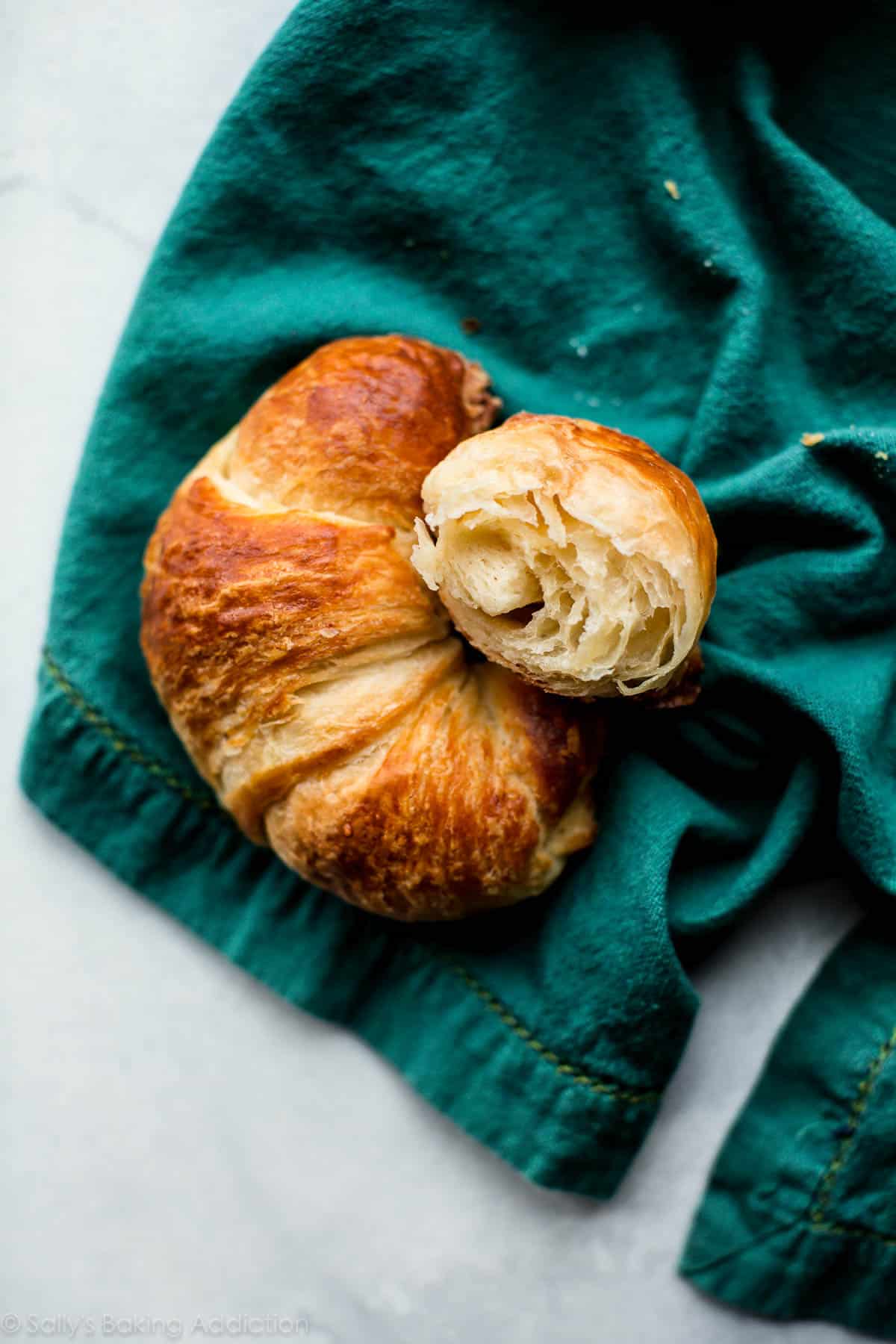
Let’s get right into it. Just like making mille-feuille, making croissants is a labor of love. The long recipe directions and all these step-by-step photographs seem intimidating, but let me walk you through the basic process so you aren’t nervous.
The Process
- Make easy dough from butter, flour, sugar, salt, yeast, and milk.
- Roll out dough into a large rectangle.
- Make the butter layer (I have an easy trick for this!!!).
- Enclose the butter layer inside the dough.
- Roll out the dough into another large rectangle, then fold it back together.
- Roll out the dough again, fold it back together again.
- Roll out the dough one more time, fold it back together.
- Shape the croissants.
- Bake!
There’s resting time between most steps, which means most of the time is hands off. To help us develop all the layers, croissant dough needs to rest in the refrigerator often. That’s why I call making croissants a project. Do it over a couple days with long breaks between the steps.

All that rolling out and folding back together? That’s called LAMINATING.
What is Laminated Dough?
Laminating dough is the process of folding butter into dough many times, which creates multiple alternating layers of butter and dough. When the laminated dough bakes, the butter melts and creates steam. This steam lifts the layers apart, leaving us with dozens of flaky airy buttery layers. Same process that makes our Chicago-style deep dish pizza crust so buttery and flaky!
Just like we do when we make a croissant bread loaf or homemade cruffins, we’re going to laminate the dough 3 times, which will create 81 layers in our croissants. Yes, 81! Let me paint that picture for you.
- Start with dough, butter layer, dough = 3 layers
- Roll it out and fold it into thirds = 9 layers
- Roll that out and fold it into thirds = 27 layers
- Roll that out one last time and fold it into thirds = 81 layers
So we’re only laminating the dough 3 times, but that gives us 81 layers. When the croissants are rolled up and shaped, that’s one 81 layer dough rolled up many times. So when you bite into a croissant, you’re literally biting into hundreds of layers.
Isn’t that SO COOL???

Croissants Video Tutorial
Watch me make croissants in this video. I talk you through the whole video too.
Now let’s see everything come together in step-by-step photographs.

DOUGH
Croissant dough begins with butter, flour, sugar, salt, yeast, and milk. Unlike most yeasted doughs that require warm liquid to activate the yeast, you’re going to use cold milk. The yeast will work its magic later on in the recipe. In the beginning steps of croissants, the dough should always be cold. If, at any point, the dough becomes too warm… stop. Stop what you’re doing and place the dough back in the refrigerator for 20 minutes.
The mixer will beat the dough for about 5 minutes. Stand by your mixer as it works the dough. This dough isn’t particularly heavy, but your mixer will still get a workout. Did you see my Instagram story when my mixer FELL OFF MY COUNTER? I walked away at the wrong time and the whole thing danced off the counter. Unplugged itself and everything. Don’t make my mistake!
See my How to Knead Dough video tutorial if you need any extra help with the kneading step.
We made the dough, now we’re going to cover it and let it rest in the refrigerator for 30 minutes.
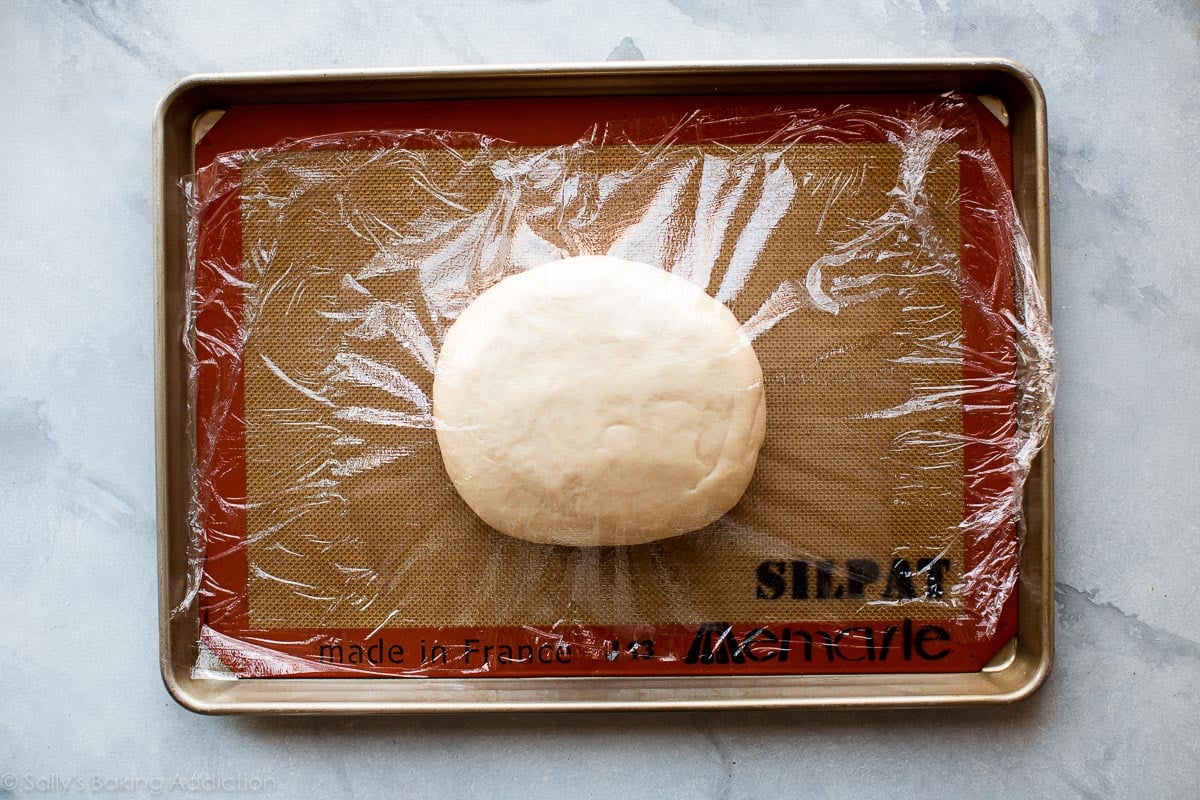
Now let’s roll out the dough into a 14×10-inch rectangle. Use a clean ruler or measuring tape. The ruler or measuring tape, besides your rolling pin, is the most crucial tool when making croissants.
I recommend using a silicone baking mat. While we will still lightly flour it, the mat is nonstick and it’s a handy guide for the exact measurement. You also need to transfer the dough to a baking sheet and the silicone baking mat makes that possible.
The dough isn’t extremely cold after only 30 minutes in the refrigerator, so it will be easy to roll out. Be precise with the 14×10-inch measurement. The dough will want to be oval shaped, but keep working the edges with your hands and rolling pin until you have the correct size rectangle. You can see how I do all this in the video below.
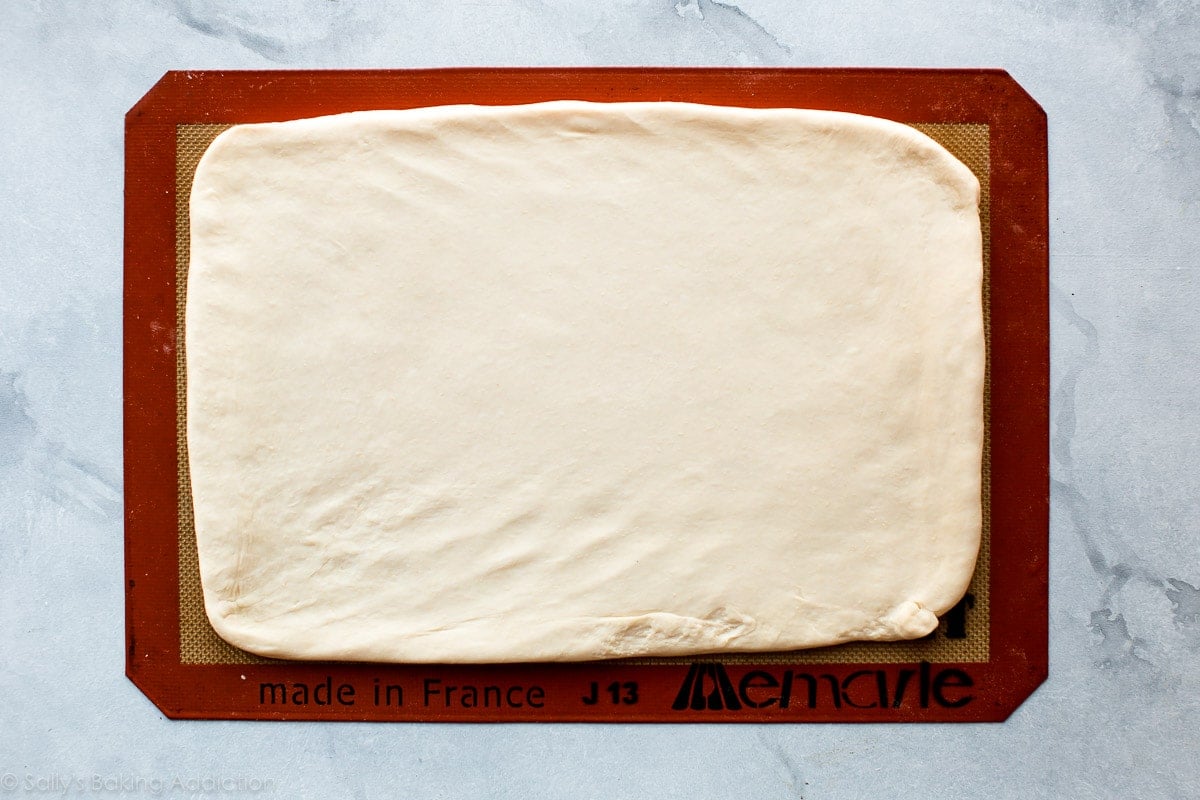
Cover the rolled out dough and chill it for 4 hours or overnight. Literally pick up the silicone baking mat, put it on top of your baking sheet, cover the dough, and chill it. I usually chill it for 4 hours because there is one more 4 hour or overnight chill period coming up. That’s when I typically chill it overnight, making this a 2 day recipe.
BUTTER
Many croissant recipes instruct you to shape extremely cold butter into a rectangle or square. Have you ever tried to manipulate cold sticks of butter into another shape? It’s really hard. I learned the following trick from Zoe at Zoe Bakes. Please go follow Zoe, she is the absolute best. ♥
Start with softened butter, beat it with flour so it has some stability, then spread into a rectangle and chill it. It’s 100x easier to shape softened butter than it is to shape cold butter. Thank you, Zoe!
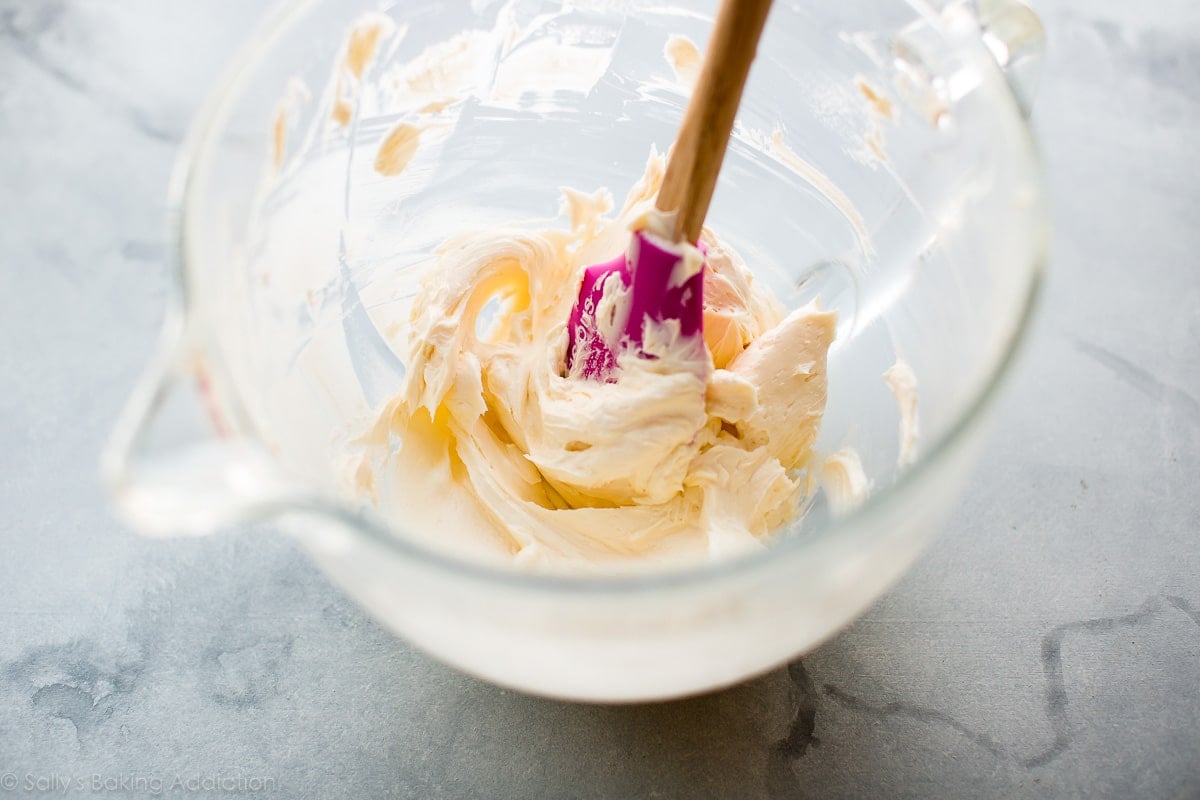
You can use any butter you like best. If you’re going to spend money on European style butter, croissants are when to do it. If I’m being honest, I use store-brand butter and love the croissant’s flavor. It’s butter. It’s going to be good regardless.
The butter rectangle is 7×10 inches, half the length of the dough and the same width, so it fits into the dough. We will chill the butter rectangle right on the silicone baking mat. After it’s chilled, we can peel it right off and place it on the dough to begin lamination.
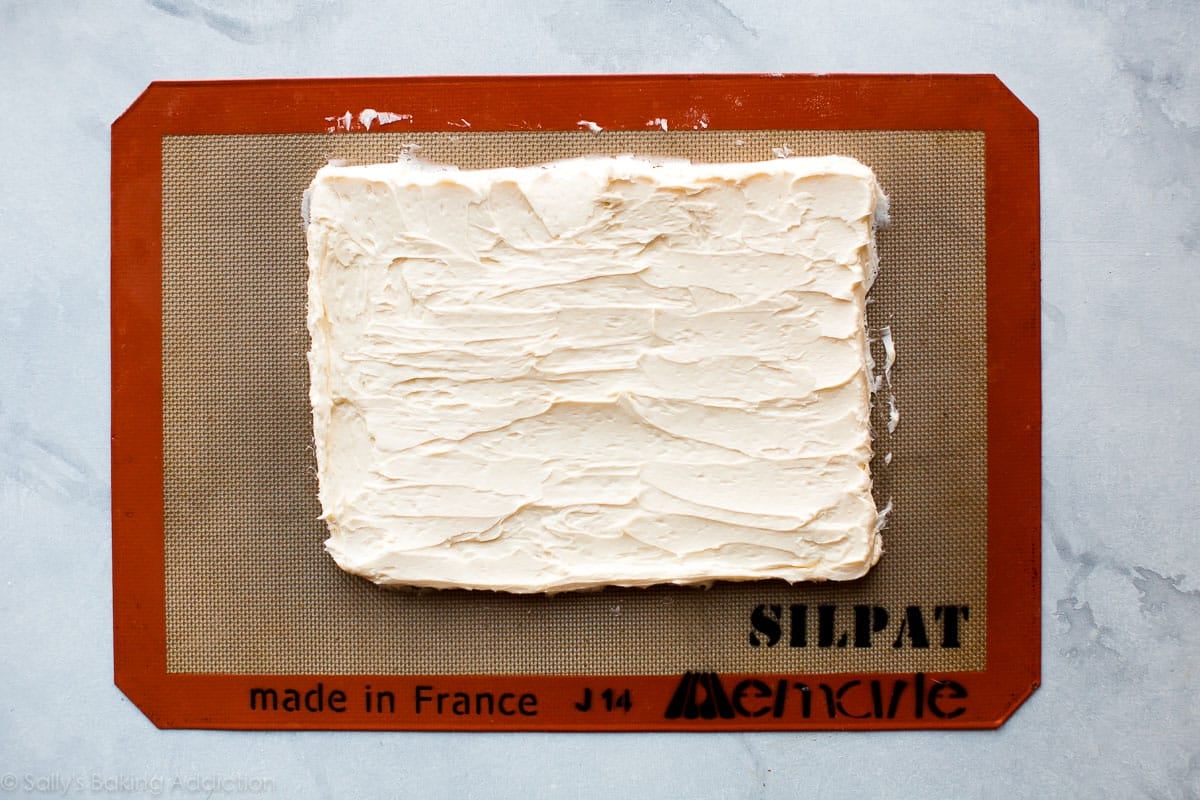
Make sure you only chill the butter for about 30 minutes. Our goal is to have the croissant dough and butter be the same temperature. It makes lamination possible. Butter solidifies much quicker than a soft dough, so that’s why our dough will chill for 4 hours and our butter will only chill for 30 minutes. Make sense?

Because you shaped the butter into the precise 7×10-inch size, it fits nicely on the 14×10-inch dough. (After the butter rectangle chills, you can always cut sharp edges with a pizza cutter or knife to make it the appropriate size.)
Fold the cold dough over the cold butter. Use your fingers to seal the butter inside.
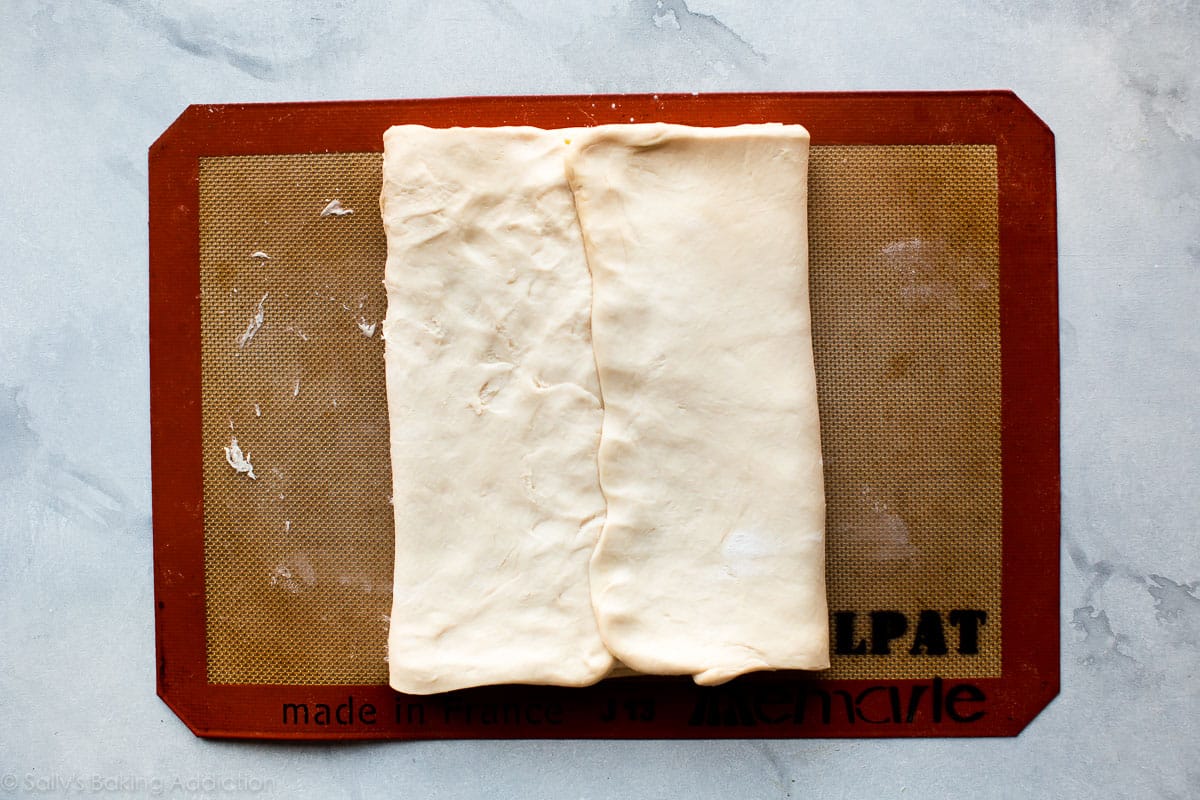
Now we’re going to laminate the dough 3x with a 30 minute break between the 2nd and 3rd time. Why between the 2nd and 3rd time? Because our dough has been out of the refrigerator for long enough by this point and needs to be chilled again. 30 minutes is plenty.
I do not have step-by-step pictures of the lamination process because it’s time sensitive and the dough just became too warm as I tried to set up the shot. However, you can see me laminate the dough and talk through the process in the video below. (3:20-5:15 minutes) Watching me work through this step is more helpful anyway.
Our dough has been rolled out and folded 3x, now it’s time to rest.
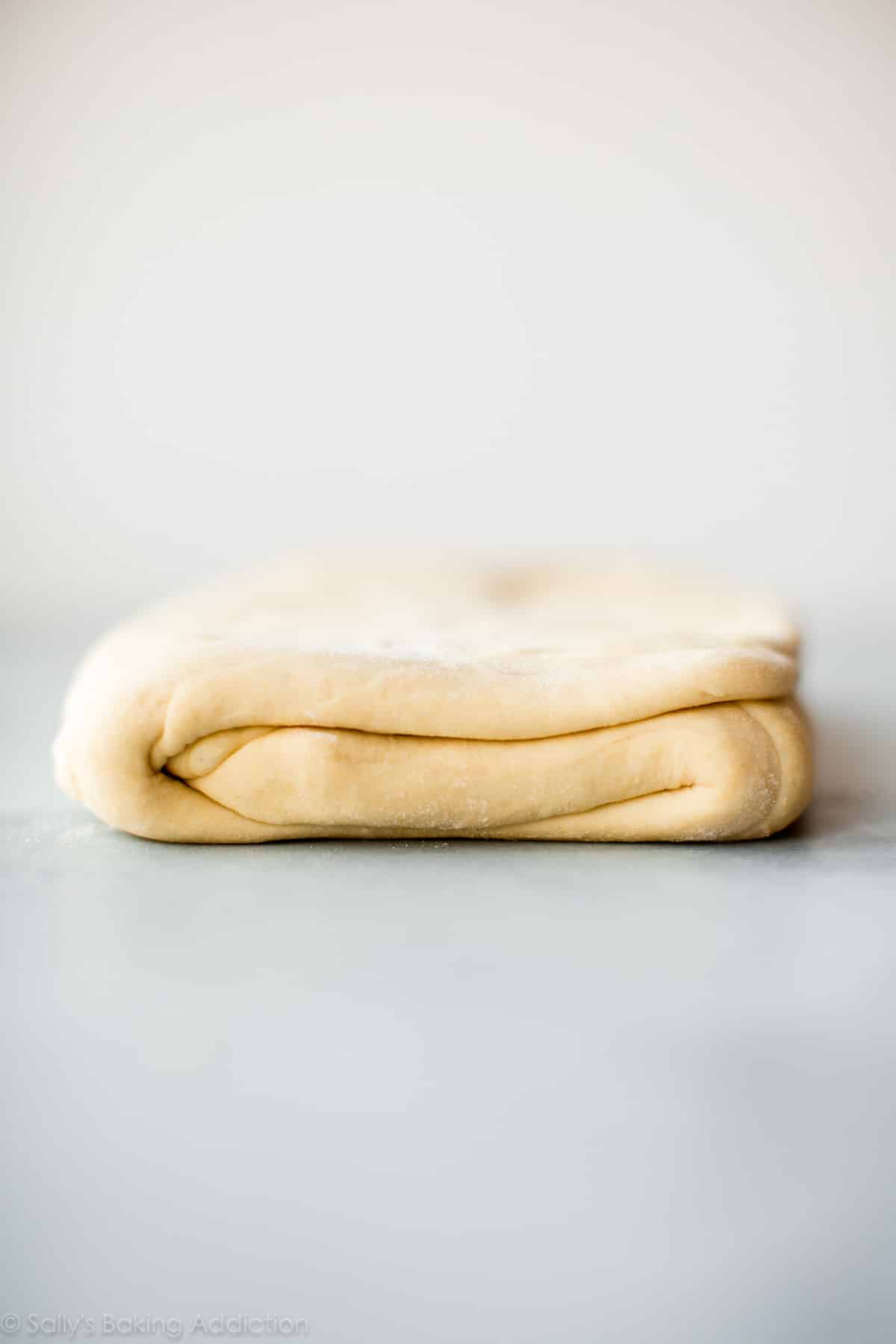
Cover the laminated dough and chill it for 4 hours or overnight. This is when I usually chill it overnight.

Roll out the dough 1 more time. This time you’ll roll it into an 8×20-inch rectangle.
Use your pizza cutter and slice the rectangle down the center to create two 4×20 rectangles. Then slice across 3x to create eight 4×5-inch rectangles.
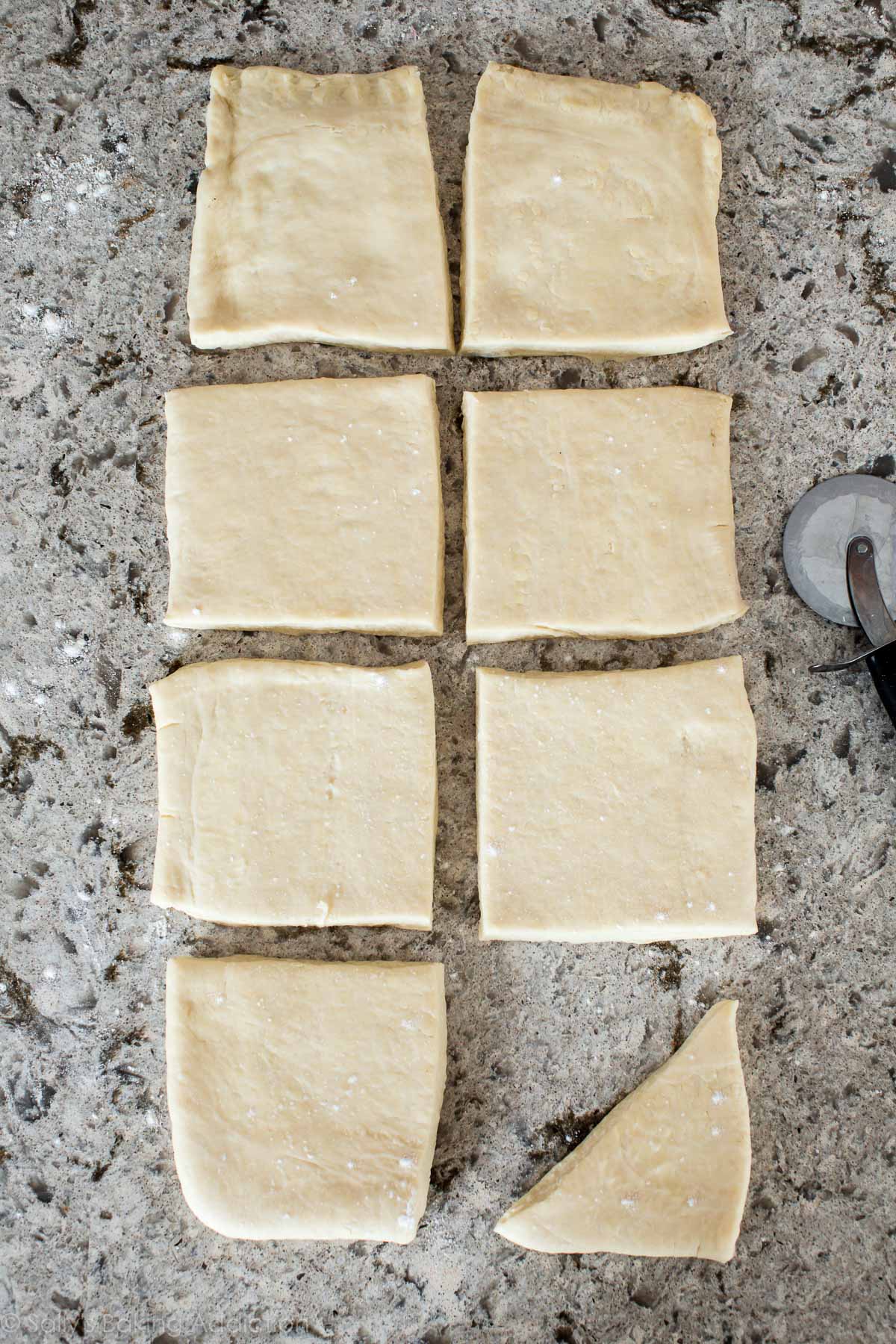
Look at all these layers!!!!
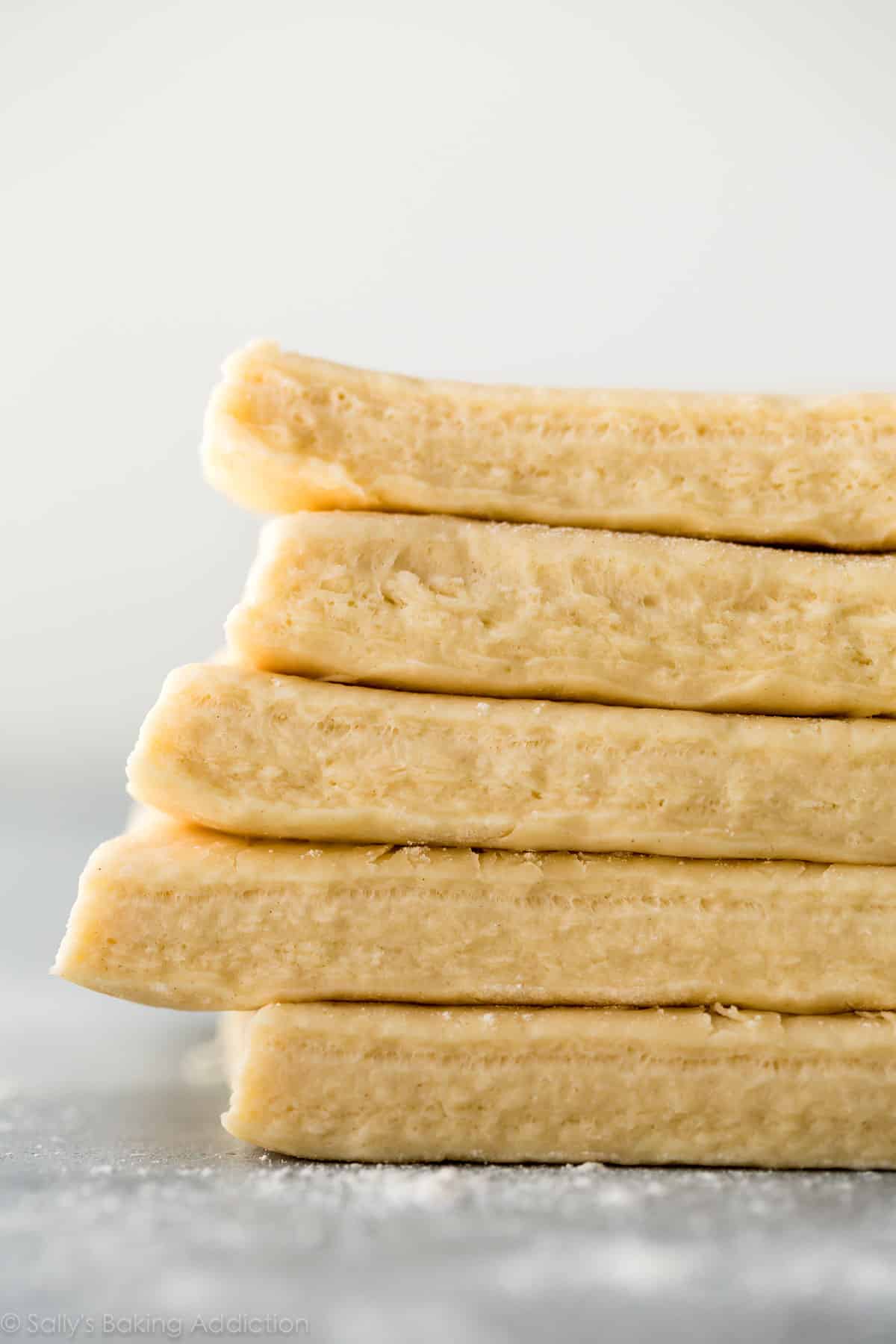
Now slice each of the 8 rectangles into 2 triangles. Using your fingers or a rolling pin, stretch the triangles to be about 8 inches long. Do this gently as you do not want to flatten the layers. Cut a small slit at the wide end of the triangle, then tightly roll up into a crescent shape making sure the tip is underneath.
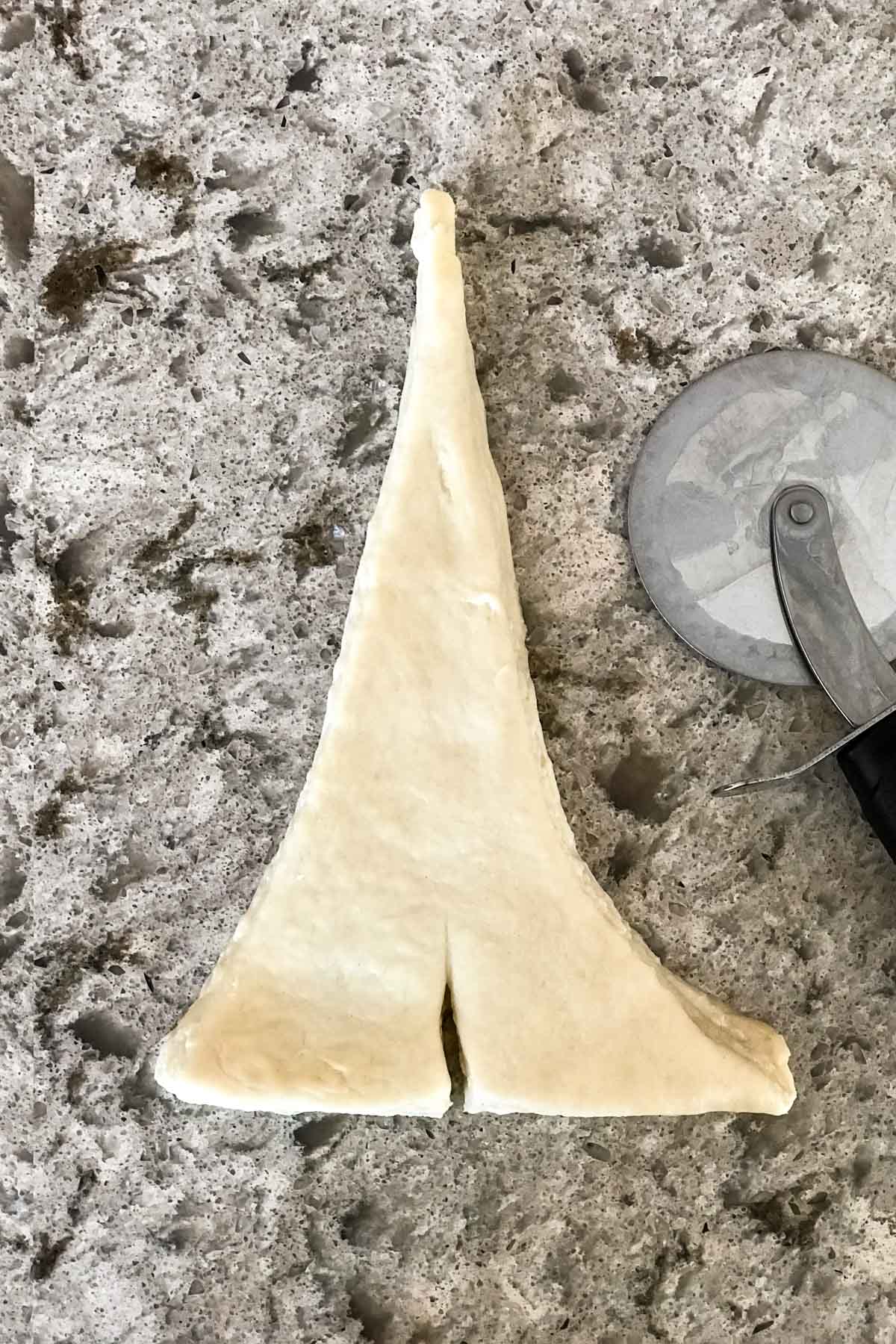
Loosely cover the shaped croissants and allow to rest at room temperature (I suggest just keeping them on the counter) for 1 hour, then place in the refrigerator to rest for 1 hour. Unlike a lot of croissant recipes, I prefer the shaped croissants to be cold going into the oven. They won’t spread as much. They will rise and proof for the 1 hour at room temperature and continue to do so in the refrigerator for another hour.
The croissants are ready to bake after that! FINALLY.
Brush them with egg wash (egg + milk).
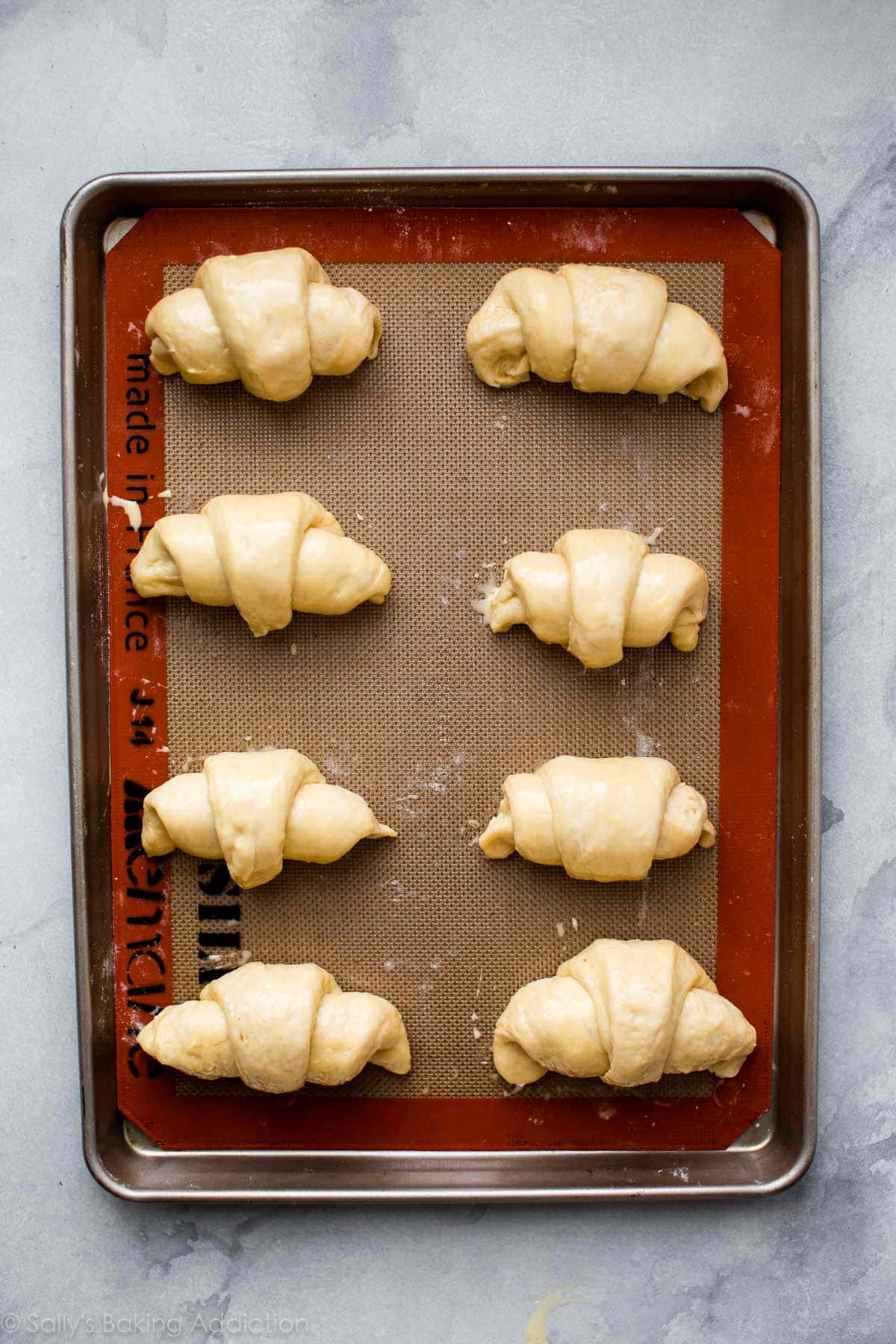
Bake.

Indulge. Because after making the dough and rolling it out a million times, you completely deserve to. Enjoy them plain or with jam, honey butter, or homemade raspberry sauce. Interested in chocolate croissants? Of course you are!
If you happen to have any leftovers, day old croissants are perfect so soak up flavors in an easy breakfast casserole.

FAQ: Why Are There Are Chunks of Butter in my Dough & Why Did Butter Leak Out of the Croissants?
These are 2 common questions and I’m happy to sum it all up for you. Some butter leakage during the baking process is normal and expected, however if your baking croissants are sitting on pools of butter, your butter layer may have been too cold. It would make sense to give the best temperature for the butter layer, but you’re really looking for texture. You want the dough and sheet of butter to be similar in softness. If the butter layer is too hard, it will crack and split under the dough. Let it sit at room temperature to soften before the laminating process (step 7) OR reduce the chill time in step 6 down from 30 minutes to about 15.
See Your Croissants!
Many readers tried this recipe as part of a baking challenge! Feel free to email or share your recipe photos with us on social media. 🙂
Print
How to Make Croissants
- Prep Time: 12 hours, 45 minutes
- Cook Time: 20 minutes
- Total Time: 13 hours, 10 minutes
- Yield: 16 croissants
- Category: Pastries
- Method: Baking
- Cuisine: French
Description
Buttery, flaky, and perfect homemade croissants!
Ingredients
- 1/4 cup (4 Tbsp; 56g) unsalted butter, softened to room temperature
- 4 cups (500g) all-purpose flour (spooned & leveled), plus more for rolling/shaping
- 1/4 cup (50g) granulated sugar
- 2 teaspoons salt
- 1 Tablespoon active dry or instant yeast
- 1 and 1/2 cups (360ml) cold whole milk
Butter Layer
- 1 and 1/2 cups (340g) unsalted butter, softened to room temperature
- 2 Tablespoons (16g) all-purpose flour
Egg Wash
- 1 large egg
- 2 Tablespoons (30ml) whole milk
Instructions
- Preliminary notes: Watch the video below and use the step-by-step photos before you begin. Read the recipe before beginning. Make room in the refrigerator for a baking sheet. In step 6 and again in step 13, you will need room for 2 baking sheets.
- Make the dough: Cut the butter in four 1-Tablespoon pieces and place in the bowl of an electric stand mixer fitted with the dough hook attachment (or you can use a handheld mixer or no mixer, but a stand mixer is ideal). Add the flour, sugar, salt, and yeast. Turn the mixer on low-medium speed to gently combine the ingredients for 1 minute. With the mixer running, slowly pour in the milk. Once all of the milk is added, turn the mixer up to medium speed and begin to knead the dough.
- Knead the dough: Keep the dough in the mixer and beat for an additional 5 full minutes, or knead by hand on a lightly floured surface for 5 full minutes. (If you’re new to bread-baking, my How to Knead Dough video tutorial can help here.) If the dough becomes too sticky during the kneading process, sprinkle 1 teaspoon of flour at a time on the dough or on the work surface/in the bowl to make a soft, slightly tacky dough. Do not add more flour than you need because you do not want a dry dough. After kneading, the dough should still feel a little soft. Poke it with your finger—if it slowly bounces back, your dough is ready to rest. You can also do a “windowpane test” to see if your dough has been kneaded long enough: tear off a small (roughly golfball-size) piece of dough and gently stretch it out until it’s thin enough for light to pass through it. Hold it up to a window or light. Does light pass through the stretched dough without the dough tearing first? If so, your dough has been kneaded long enough and is ready to rest. If not, keep kneading until it passes the windowpane test.
- Remove dough from the bowl and, with floured hands, work it into a ball. Place the dough on a lightly floured silicone baking mat lined, lightly floured parchment paper lined, or lightly floured baking sheet. (I highly recommend a silicone baking mat because you can roll the dough out in the next step directly on top and it won’t slide all over the counter.) Gently flatten the dough out, as I do in the video below, and cover with plastic wrap or aluminum foil. Place the entire baking sheet in the refrigerator and allow the covered dough to rest in the refrigerator for 30 minutes.
- Shape the dough: Remove the dough from the refrigerator. I like to keep the dough on the silicone baking mat when I’m rolling it in this step because the mat is nonstick and it’s a handy guide for the exact measurement. Begin flattening out the dough with your hands. You’re rolling it out into a rectangle in this step, so shaping it with your hands first helps the stretchy dough. Roll it into a 14×10-inch rectangle. The dough isn’t extremely cold after only 30 minutes in the refrigerator, so it will feel more like soft play-doh. Be precise with the measurement. The dough will want to be oval shaped, but keep working the edges with your hands and rolling pin until you have the correct size rectangle.
- Long rest: Place the rolled out dough back onto the baking sheet (this is why I prefer a silicone baking mat or parchment because you can easily transfer the dough). Cover the rolled out dough with plastic wrap or aluminum foil, place the entire baking sheet in the refrigerator and allow the covered dough to rest in the refrigerator for 4 hours or overnight. (Up to 24 hours is ok.)
- Butter layer (begin this 35 minutes before the next step so the butter can chill for 30 minutes): In a large bowl using a hand-held mixer or stand mixer fitted with a paddle or whisk attachment, beat the butter and flour together until smooth and combined. Transfer the mixture to a silicone baking mat lined or parchment paper lined baking sheet. (Silicone baking mat is preferred because you can easily peel the butter off in the next step.) Using a spoon or small spatula, smooth out into a 7×10-inch rectangle. Be as precise as you can with this measurement. Place the entire baking sheet in the refrigerator and chill the butter layer for 30 minutes. (No need to cover it for only 30 minutes.) You want the butter layer firm, but still pliable. If it gets too firm, let it sit out on the counter for a few minutes to gently soften. The more firm the butter layer is the more difficult it will be to laminate the dough in the next step.
- Laminate the dough: In this next step, you will be rolling out the dough into a large rectangle. Do this on a lightly floured counter instead of rolling out on your silicone baking mat. The counter is typically a little cooler (great for keeping the dough cold) and the silicone baking mat is smaller than the measurement you need. Remove both the dough and butter layers from the refrigerator. Place the butter layer in the center of the dough and fold each end of the dough over it. If the butter wasn’t an exact 7×10-inch rectangle, use a pizza cutter or sharp knife to even out the edges. Seal the dough edges over the butter layer as best you can with your fingers. On a lightly floured counter, roll the dough into a 10×20-inch rectangle. It’s best to roll back and forth with the shorter end of the dough facing you, like I do in the video below. Use your fingers if you need to. The dough is very cold, so it will take a lot of arm muscle to roll. Again, the dough will want to be oval shaped, but keep working it with your hands and rolling pin until you have the correct size rectangle. Fold the dough lengthwise into thirds as if you were folding a letter. This was the 1st turn.
- If the dough is now too warm to work with, place folded dough on the baking sheet, cover with plastic wrap or aluminum foil, and refrigerate for 30 minutes before the 2nd turn. I usually don’t have to.
- 2nd turn: Turn the dough so the short end is facing you. Roll the dough out once again into a 10×20-inch rectangle, then fold the dough lengthwise into thirds as if you were folding a letter. The dough must be refrigerated between the 2nd and 3rd turn because it has been worked with a lot by this point. Place the folded dough on the baking sheet, cover with plastic wrap or aluminum foil, and refrigerate for 30 minutes before the 3rd turn.
- 3rd turn: Roll the dough out once again into a 10×20-inch rectangle. Fold the dough lengthwise into thirds as if you were folding a letter.
- Long rest: Place the folded dough on the lined baking sheet, cover with plastic wrap or aluminum foil, and refrigerate for 4 hours or overnight. (Up to 24 hours is ok.)
- At the end of the next step, you’ll need 2 baking sheets lined with silicone baking mats or parchment paper. The dough is currently on a lined baking sheet in the refrigerator, so you already have 1 prepared!
- Shape the croissants: Remove the dough from the refrigerator. On a lightly floured counter, roll the dough out into an 8×20-inch rectangle. Use your fingers if you need to. Once again, the dough is very cold, so it will take a lot of arm muscle to roll. The dough will want to be oval shaped, but keep working it with your hands and rolling pin until you have the correct size rectangle. Using a pizza cutter or sharp knife, slice the dough in half vertically. Each skinny rectangle will be 4-inches wide. Then cut 3 even slices horizontally, yielding 8 4×5-inch rectangles. See photo above for a visual. Cut each rectangle diagonally to make 2 triangles. You have 16 triangles now. Work with one triangle at a time. Using your fingers or a rolling pin, stretch the triangle to be about 8 inches long. Do this gently as you do not want to flatten the layers. Cut a small slit at the wide end of the triangle, then tightly roll up into a crescent shape making sure the tip is underneath. Slightly bend the ends in towards each other. Repeat with remaining dough, placing the shaped croissants on 2 lined baking sheets, 8 per sheet. Loosely cover with plastic wrap or aluminum foil and allow to rest at room temperature (no warmer—I suggest keeping on the counter) for 1 hour, then place in the refrigerator to rest for 1 hour or up to 12 hours. (Or freeze, see freezing instructions.) I prefer the shaped croissants to be cold going into the oven.
- Preheat oven to 400°F (204°C).
- Egg wash: Whisk the egg wash ingredients together. Remove the croissants from the refrigerator. Brush each lightly with egg wash.
- Bake the croissants: Bake until croissants are golden brown, about 20 minutes. Rotate the pans halfway through baking. If croissants show signs of darkening too quickly, reduce the oven to 375°F (190°C).
- Remove croissants from the oven and place on a wire rack to cool for a few minutes before serving. They will slightly deflate as they cool.
- Croissants taste best the same day they’re baked. Cover any leftover croissants and store at room temperature for a few days or in the refrigerator for up to 1 week. You can also freeze for up to 3 months, then thaw on the counter or overnight in the refrigerator. Warm up to your liking.
Notes
- Make Ahead Instructions: Croissants are perfect for getting started ahead of time. The dough can rest for 4 hours or overnight in step 5 and again in step 11. You can also freeze the dough after the 3rd turn in the lamination process (after step 10). Instead of the 4 hour rest in the refrigerator in step 11, wrap the dough tightly in plastic wrap or aluminum foil, place in a freezer zipped-top bag, and freeze for up to 3 months. Thaw in the refrigerator and continue with step 12. You can also freeze the shaped croissants after they rest for 1 hour at room temperature in step 13. (Before placing in the refrigerator.) Cover them tightly and freeze for up to 1 month. Thaw completely in the refrigerator, then bake as directed.
- Special Tools (affiliate links): Stand Mixer (preferred), Hand Mixer, or Glass Mixing Bowl with Wooden Spoon / Silicone Spatula | Rolling Pin | Pizza Cutter | Pastry Brush | Silicone Baking Mat or Parchment Paper | Baking Sheet | Cooling Rack
- Yeast: I use and recommend Red Star Platinum, an instant yeast. You can use active dry yeast instead if needed. No changes to the recipe or prior proofing required; just mix it in as instructed. (Most modern yeasts are already active!) Reference my Baking with Yeast Guide for answers to common yeast FAQs.
- Keep Dough Cold: Make sure the dough is ALWAYS cold. If it warms up too much, stop what you’re doing and place the dough back in the refrigerator for 20 minutes.
- Floured Surface: Lightly flour the work surface, your hands, the dough, and the rolling pin as you work.
- Air Bubbles: Are there air bubbles in your dough as you roll? That’s ok. Pop them with your fingers or a toothpick, then lightly flour where you popped the air bubble.
- Croissants for Brunch: I recommend starting the recipe the day before in the early afternoon. Complete steps 1-10, then let the laminated dough have a long rest in the refrigerator overnight (step 11). Begin step 13 2-3 hours before brunch.
- Dough adapted from Joy of Baking, Food & Wine, and Epicurious

















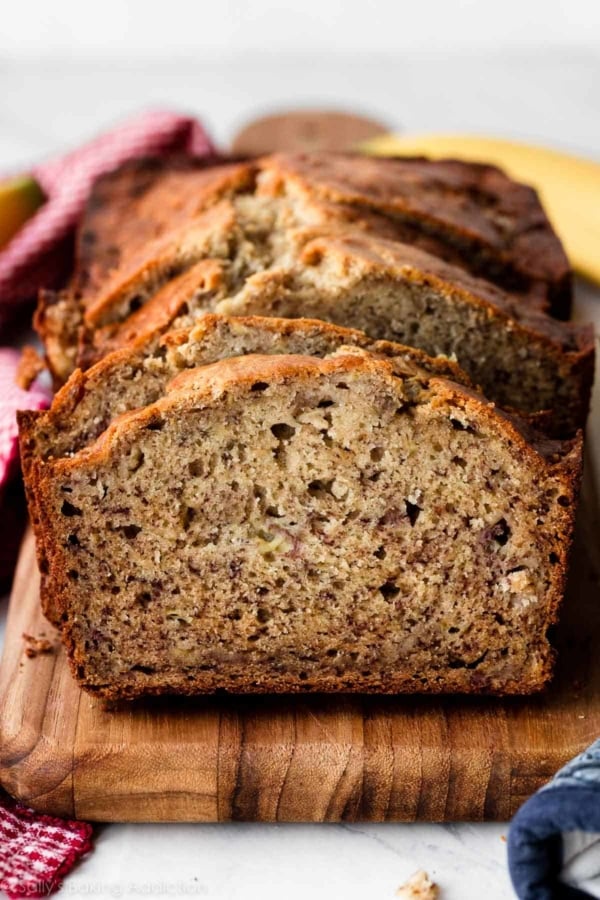

Reader Comments and Reviews
If I halve this recipe, should I also just halve the dough and butter rectangle dimensions?
For best results, we highly recommend making the recipe as written and freezing the extra croissants. (Always nice to have some on hand!) If you really want to halve the recipe, the dimensions should be halved too.
So, if the butter breaks into segments/pieces during the first step of rolling & laminating, is that because it is too cold? I timed it exactly at 30 minutes in frig, but had no idea what pliable butter looked like.
Hi Kristin, yes, it does sound like your butter was a bit too cold. For next time, you can shorten that 30 minutes just a bit to ensure it doesn’t harden too much.
This is my 4th attempt at croissants, my first with Sally’s recipe. KUDOS. This was, hands down, my most successful lamination–the dough had gorgeous layers! It was also the easiest dough I’ve ever worked with. But something didn’t go exactly right in the proofing stage . . . first off, the dough that came out of the refrigerator after the overnight rest had a crust on top of it (I suspect I hadn’t covered it tightly enough.) This compromised the final roll out and in the end the finished croissants didn’t rise as fully as I thought they should. VERY flaky and lots of lovely layers, just a little too dense.
Hi AW, You can try a milk wash instead of an egg wash for a nice, shiny top. So glad they were a hit!
ok thanks! also when baking from frozen, do they need to proof at room temperature at all? or just be completely thawed? I noticed some recipes say to proof them at room temperature for a few hours but it doesn’t appear to be the case for your recipe?
When rolling for lamination before final roll-out what dimensions do you use?
Hi Ty, aim for a 10×20-inch rectangle.
I guess I can’t read. Good news, this recipe worked after I had repeated failed results from other recipes that avoided a butter block. I even had minor screwups and they rose well with limited butter leakage.
Hello! My husband and I renovated our kitchen 1.5 years ago and I promised myself I would learn to make croissants when it was done. Well a year and half later, I think I’m finally ready to take on the challenge and this seems like the most perfect recipe to try out.
I do have a question. I see that you have this one and a recipe for chocolate ones. Is there any chance we will see an almond croissant version from you? Or do you have any advice/tips/previously answered questions about almond croissants?
Hi Caitlyn, how exciting! We haven’t tried almond croissants yet. We would love to hear how your croissants go!
Great recipe, I’ve used it before and they turned out first try. This time I was hoping to fill the croissants with ham and gruyere cheese but I would like to know the potential pitfalls of adding filling? Anything to watch out for?
I would add it right before i roll them up into croissant shapes, I imagine.
Hi Reilly, We can’t see why not. You could even roll them like we do with these filled chocolate croissants.
hi sally, what happens if i don’t have a silicone baking sheet?
Hi AW, we recommend baking the croissants on parchment paper if you do not have a silicone baking mat. Enjoy!
This recipe is amazing and I love the detailed instructions! Mine came out perfectly! I was wondering if there was a way to make these shaped like circular buns for breakfast sandwiches? I was thinking maybe if instead of cutting into squares/triangles if I rolled the laminated dough into a log and cut it into circles that way it may work but figured id ask you first haha!
Hi Samantha! We haven’t tested that but would love to hear how it goes if you do :). So glad you love this recipe!
I rarely comment on reviews, but this was magic. I followed the instructions exactly. I used a measuring tape. The last long rest was overnight and I baked them this morning. I made 4 of them with dark chocolate. They were nearly perfect. I need to work on my rolling. They are tender and flaky. Thank you for this !
I have a question I made my croissant dough, after the 3rd lamination put it in the fridge overnight do I still let it rise for an hour outside the fridge and an hour back in the fridge. Is it important for the croissants to be cold before baking?
Hi Kimberly, correct. See end of step 14: “Loosely cover with plastic wrap or aluminum foil and allow to rest at room temperature (no warmer—I suggest keeping on the counter) for 1 hour, then place in the refrigerator to rest for 1 hour or up to 12 hours. (Or freeze, see freezing instructions.) I prefer the shaped croissants to be cold going into the oven.”
Hi Sally! I’ve made croissants in the past but this is my first time using your recipe. Is it possible to make 8-10 larger croissants instead of 16 smaller ones?
Hi Maddie, that should be fine, although the bake time will be a bit longer. We’re unsure of the exact timing. Let us know what you try!
These are amazing! Am I able to double the recipe? If so how would I go about doing that?
Hi Ahna, for best results (and to prevent over or under mixing/working the dough), we recommend making separate batches rather than doubling. We are so glad you love this croissant recipe! Thanks for giving it a try.
First time baking them, loved the clear instructions and the video to check the folding techniques. Thanks!
Mine aren’t anywhere near done in the middle at 20 minutes. What am I doing wrong?
Hi Bet, Make sure you’re closely following the recipe including each particular folding/laminating step. If the croissants are doughy/raw in the middle, they likely need a bit more time in the oven. You can extend the baking time by a few minutes until they are baked through. Hope this helps!
Hello! I’m interested in making these croissants-they look so yummy!! However, I’m trying to avoid sugar right now and was wondering if there was an ingredient I could replace it with. Do you have any suggestions?
Hi Hannah! We’d love to help but we are not trained in baking with sugar substitutes. For best taste and texture (and so you don’t waste your time trying to adapt this recipe since it may not work properly), it may be more useful to find a recipe that is specifically formulated for sugar substitutes. Thank you!
Typically, dough is proofed in a warm environment until it doubles in size. In your video, however, the dough is rested in the refrigerator for 30 minutes. Could you clarify whether this step serves the same purpose as proofing? Would there be any difference if the dough were proofed before being placed in the refrigerator for 30 minutes?
Hi Rung, croissants are different than other yeasted doughs. Resting the dough in the fridge keeps the butter cold and creates the flaky layers.
Hi, so while I was trying to laminate the dough my butter completely melted and started leaking through the dough making it extermely difficult to laminate. So I put the dough and butter in the refridgerator to chill and freeze overnight. Is there any other way to do this?
Hi Allison, sorry to hear this step was difficult for you! Did you chill the dough and the butter before laminating? Did you chill for 30 minutes between the 2nd and 3rd time? It sounds like your dough may have become too warm during the process, an easy fix for next time! The step-by-step instructions between the step photos and the video tutorial might be helpful for next time! Thanks for giving this recipe a try.
Hi, Can I use salted butter instead of unsalted?
Hi Allison, you can use salted butter if desired.
These taste like dinner rolls and aren’t flaky. This recipe sure made making croissants easy though!
These were wonderful! We made a half batch and everything halved beautifully. We did a 7×10″ rectangle for the initial rectangle, a 5×7″ rectangle for butter, and an 8×10″ rectangle for the folds and the final shape.
Came out perfect thank you
These were delicious but not as airy as those I had in Paris. Any ideas on how to make them fluffier?
Hi Gerald, was the dough sufficiently kneaded? If the dough isn’t kneaded enough, or is over-kneaded, your baked bread won’t rise as high, and the overall texture and appearance will be dense. Properly kneaded dough promises a softer, fluffier, taller, and chewier croissant. We hope this helps for your next batch!
I made these for the first time (some with chocolate and others with ham and Swiss cheese) and they were great, the recipe was really easy to follow. The only problem I encountered (and I’ve had the same issue when making things with puff pastry) is that after 20 min the tops weren’t golden enough so I kept them in for another 4 minutes, but doing so made the bottoms too dark (still edible though). Any suggestions to get the right color without the bottoms burning?
In step 7, can I shape the butter layer to be two thirds the size of the dough layer instead of half the size? This way I can do a letter fold when first placing the butter layer on the dough and get a head start with five layers of alternating dough/butter instead of just three. This would give me 5-15-45-135 layers rather than 3-9-27-81. If I properly chill the dough between turns, is there a limit on how many laminations I can make?
I don’t think that will produce the results you’re looking for. The lamination affect in the croissant is created by the alternating layers of dough & butter (D-B-D) and anywhere where dough touches dough is just going to merge into a larger single dough layer (D-B-[DD]) that doesn’t add to the layer count. When we place the butter in and seal it up, you’re basically making layer-set #1 – we’re just setting up to start the laminating process. Think of it like this: if you did a letter fold to start, you’re folding two flaps of pure dough over the butter core. All that does is double-wrap the top of the butter slab, making your foundation (layer-set #1) completely uneven. Letter folding it in the set-up stage doesn’t gain you any layers because you’re wrapping it in plain dough (setting up) instead of layered dough (folding).
I think a better way to accomplish what you want would be to roll out the layered dough into a longer rectangle and do an additional fold or two in the letter fold, thereby packing in more folds into a single folding/rolling session. That being said, I’m not an expert and there could be a really good reason that doesn’t work as well as I think it might; I’ll leave the Sally’s staff to comment on that!
Great recipe with really easy to follow steps! However, I had a large amount of trouble with shaping them. I couldn’t get them stretched enough without either the dough tearing or having to flatten it out with a rolling pin. Not sure how to fix
Hi Keira! If you find that the dough is overly sticky and is tearing as you work with it, sprinkle more and more flour on it as you shape it and roll it out. Keep the dough as cold as possible, even if that means stopping during any point and refrigerating it for 15-20 minutes before continuing. If it didn’t seem sticky, but stiff and tearing, there could have been too much flour in the dough. How did you measure the flour? Make sure to spoon and level (instead of scooping) to avoid packing in too much flour into your measuring cups – or use a kitchen scale. You can read more about properly measuring baking ingredients in this post.
If I use active dry yeast, do I need to let it dissolve and foam in liquid like I would for regular bread? Or does it just go in as is?
Hi Sydney! You can follow the recipe as written using active dry yeast.
If I am halfing the recipe, do I still make the dough and butter rectangles the same size?
For best results, we highly recommend making the recipe as written and freezing the extra croissants. (Always nice to have some on hand!) If you really want to halve the recipe, the dimensions should be halved too.
I make these at least once a month and they are phenomenal!
Curious if anyone has tried using GF flour in this recipe?
I have a friend who is celiac and mentioned how she would love a croissant.
I have done a lot of gluten free making but many gluten free flours say on the package they shouldn’t be used for yeast baking. So, not sure if this is possible for GF?
Do you have any tips for how to fix it if your butter layer was too cold and has left lumps of butter throughout your dough, or is it just a lost cause at that point and I should just cry?
Hi Keren, how did the croissants bake up for you? It sounds like the butter was simply too hard inside your dough and these hard pieces/chunks of butter can pool out when baked. Before any point where you are rolling the dough or shaping the laminated dough, let it sit on the counter until the butter has slightly softened and isn’t hard and chunky underneath the layers. You’ll have an easier time laminating the dough and the butter shouldn’t pool out as much. Hope this helps for next time!
Hi just an observation that may help with the butter block. I take my 3 sticks line them on parchment paper and place another piece on top, then use a french rolling pin to beat them down and shape the butter block. I use my fingers along the edges to get them in square and try not to beat it to thin so it doesn’t get too large. This allows me to work while my butter is still decently cold and doesn’t break the block. Just a suggestion that might help you. I like to make sure I keep both my dough and butter cold.
Same happened to me, so thanks for asking. I hope you didn’t cry!